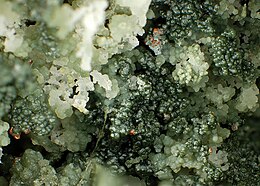| Saponite | |
|---|---|
 Saponite (light green) mixed with chamosite (dark green) and copper | |
| General | |
| Category | Phyllosilicates Smectite group |
| Formula (repeating unit) | Ca0.25(Mg,Fe)3((Si,Al)4O10)(OH)2·n(H2O) |
| IMA symbol | Sap[1] |
| Strunz classification | 9.EC.45 |
| Crystal system | Monoclinic |
| Crystal class | Prismatic (2/m) (same H-M symbol) |
| Space group | C2/m |
| Unit cell | a = 5.3 Å, b = 9.14 Å c = 16.9 Å; β = 97°; Z = 2 |
| Identification | |
| Color | White, yellow, red, green, blue |
| Crystal habit | Granular – Massive |
| Cleavage | {001} perfect |
| Tenacity | Brittle dry, plastic when hydrated |
| Mohs scale hardness | 1.5 |
| Luster | Greasy, dull |
| Streak | White |
| Diaphaneity | Translucent |
| Specific gravity | 2.24–2.30 |
| Optical properties | Biaxial (−) |
| Refractive index | nα = 1.479 – 1.490 nβ = 1.510 – 1.525 nγ = 1.511 – 1.527 |
| Birefringence | δ = 0.032 – 0.037 |
| Pleochroism | X = colorless, light yellow to green-brown; Y = Z = colorless, greenish brown to dark brown |
| 2V angle | Calculated: 20° to 26° |
| References | [2][3][4] |
Saponite is a trioctahedral mineral of the smectite group. Its chemical formula is Ca0.25(Mg,Fe)3((Si,Al)4O10)(OH)2·n(H2O).[3] It is soluble in sulfuric acid. It was first described in 1840 by Svanberg. Varieties of saponite are griffithite, bowlingite and sobotkite.
It is soft, massive, and plastic, and exists in veins and cavities in serpentinite and basalt. The name is derived from the Greek sapo, soap. Other names include bowlingite; mountain soap; piotine; soapstone.
- ^ Warr, L.N. (2021). "IMA–CNMNC approved mineral symbols". Mineralogical Magazine. 85 (3): 291–320. Bibcode:2021MinM...85..291W. doi:10.1180/mgm.2021.43. S2CID 235729616.
- ^ Webmineral data
- ^ a b Mindat.org
- ^ Handbook of Mineralogy